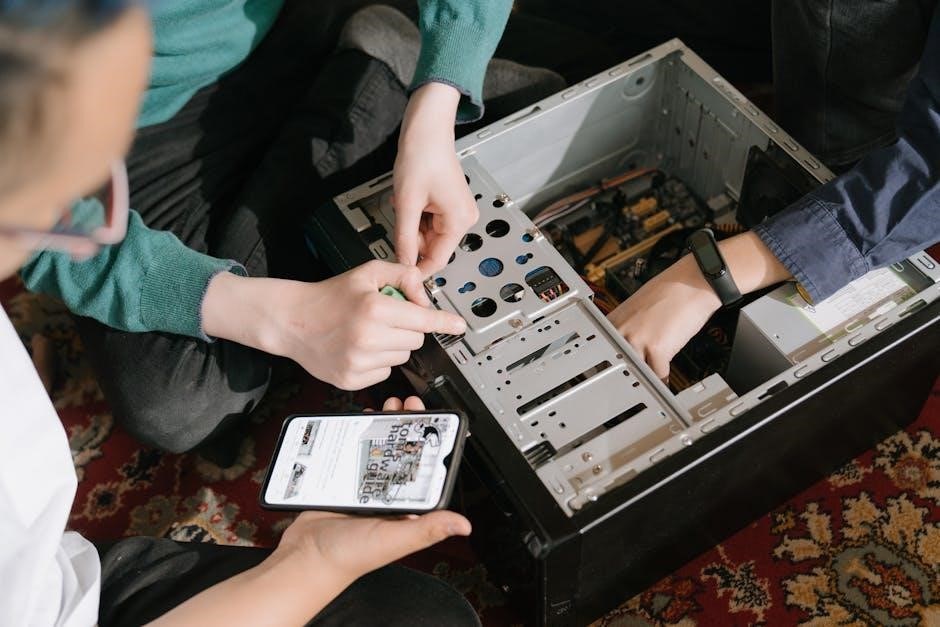This guide provides a comprehensive resource for identifying and resolving common issues with Fujitsu Mini Split systems‚ ensuring optimal performance and efficiency. From error codes to maintenance tips‚ it covers essential troubleshooting steps for homeowners and technicians alike.
1.1 Understanding Common Issues in Fujitsu Mini Split Systems
Fujitsu Mini Split systems are reliable but can encounter issues like error codes‚ low performance‚ or unusual noises. Common problems include thermistor errors‚ which affect temperature sensing‚ and control unit malfunctions. Leaks or water dripping from the unit often indicate drainage issues‚ while strange noises may signal loose parts or compressor problems. Understanding these issues helps in identifying the root cause and applying the right fix. Regular maintenance‚ such as cleaning filters and checking connections‚ can prevent many of these problems. Recognizing these signs early ensures efficient troubleshooting and prolongs system lifespan. This section outlines the most frequent issues users face and provides insights into their causes and solutions.
1.2 Importance of Regular Maintenance and Troubleshooting
Regular maintenance and timely troubleshooting are crucial for ensuring the optimal performance and longevity of Fujitsu Mini Split systems. Neglecting these practices can lead to reduced efficiency‚ higher energy bills‚ and premature system failure. Issues like dust buildup in filters or malfunctioning sensors can escalate into more severe problems if left unaddressed. Proactive maintenance‚ such as cleaning filters and inspecting drainage‚ helps prevent unexpected breakdowns. Troubleshooting common issues early saves time and money‚ ensuring consistent heating and cooling. By prioritizing maintenance‚ users can enjoy reliable operation‚ improved air quality‚ and extended system lifespan. This approach also enhances safety by preventing potential hazards like electrical faults or refrigerant leaks. Regular upkeep is essential for maximizing the benefits of your Fujitsu Mini Split system.

Common Issues with Fujitsu Mini Split Systems
Fujitsu Mini Split systems often face issues like error codes‚ low performance‚ leaks‚ unusual noises‚ and thermostat malfunctions. These problems can disrupt heating and cooling efficiency if unresolved.
2.1 Error Codes and Their Meanings
Fujitsu Mini Split systems display error codes through LED indicators‚ helping users identify specific issues. For instance‚ a thermistor error (room temperature sensor) is indicated by a red lamp‚ while control unit errors may flash green lights in sequences. Understanding these codes is crucial for quick diagnosis and resolution. Common errors include temperature sensor malfunctions‚ control unit failures‚ and communication issues between indoor and outdoor units. Referencing the user manual or online resources can provide detailed explanations for each code‚ ensuring proper troubleshooting steps are taken. Addressing these errors promptly prevents further system damage and restores optimal performance. Regular maintenance can also reduce the likelihood of encountering these issues.
2.2 Low Performance or Inadequate Cooling/Heating
Low performance or inadequate cooling/heating in Fujitsu Mini Split systems can stem from various issues. Dirty or clogged air filters often restrict airflow‚ reducing efficiency. Refrigerant leaks or improper refrigerant levels can also impair heating and cooling capabilities. Additionally‚ issues like thermostat malfunctions or incorrect settings may cause inconsistent performance. Outdoor unit problems‚ such as blocked airflow or improper installation‚ can further exacerbate the issue. Addressing these problems involves cleaning or replacing filters‚ checking refrigerant levels‚ and ensuring proper installation. Regular maintenance and inspections can help prevent such issues‚ ensuring optimal performance and energy efficiency. Promptly resolving these problems is essential to restore the system’s effectiveness and comfort.
2.3 Leaks or Water Dripping from the Unit
Leaks or water dripping from a Fujitsu Mini Split unit can indicate several issues. One common cause is a clogged or improperly installed drain system‚ which prevents condensate from draining effectively. This can lead to water accumulation and eventual dripping. Additionally‚ refrigerant leaks or damaged condensate hoses may contribute to moisture issues. In some cases‚ ice buildup on evaporator coils can melt and cause water to drip when the system defrosts. Addressing these problems involves inspecting and cleaning the drain system‚ checking for refrigerant leaks‚ and ensuring proper installation of all components. Regular maintenance can help prevent such issues‚ ensuring smooth operation and preventing water damage. Prompt repairs are essential to avoid further complications.
2.4 Unusual Noises or Vibration
Unusual noises or vibration in a Fujitsu Mini Split system can signal underlying issues. Common causes include loose screws‚ worn-out fan motors‚ or malfunctioning compressors. Rattling sounds may indicate debris in the unit‚ while humming or buzzing could point to electrical or refrigerant flow problems. Vibrations might result from improper installation or unbalanced components. To address these‚ inspect and tighten all screws‚ clean the unit‚ and check for blockages. If noises persist‚ professional diagnosis may be needed to identify internal faults like faulty motors or refrigerant leaks. Addressing these issues promptly ensures smooth operation and prevents further damage. Regular maintenance can help mitigate such problems‚ maintaining comfort and system efficiency. Always prioritize safety when investigating unusual noises.
2.5 Thermostat or Remote Control Malfunction
A malfunctioning thermostat or remote control can disrupt your Fujitsu Mini Split’s operation‚ leading to inconsistent temperature control or unresponsive commands. Common issues include dead batteries‚ faulty sensors‚ or signal interference. First‚ ensure the remote has fresh batteries and is within range. Check for obstruction between the remote and thermostat. If problems persist‚ inspect the thermostat’s wiring and sensors for damage or dirt. Resetting the system or reprogramming the thermostat may resolve the issue. If these steps fail‚ consult the user manual or contact a professional to diagnose and repair internal faults‚ ensuring precise temperature regulation and system efficiency. Always refer to the manufacturer’s guidelines for troubleshooting.

Diagnostic Tools and Techniques
Use the Fujitsu remote control and LED indicators to identify issues. Check error codes‚ thermistor readings‚ and control unit status for accurate diagnostics and troubleshooting.
3.1 Using the Fujitsu Mini Split Remote Control for Diagnostics
The remote control is a vital tool for diagnosing issues in Fujitsu Mini Split systems. By accessing the control panel‚ users can view error codes‚ adjust settings‚ and monitor system performance. LED indicators on the unit provide visual feedback‚ such as blinking patterns that correspond to specific issues. The remote allows you to check the thermistor readings and control unit status‚ enabling you to identify problems like sensor malfunctions or communication errors. Regularly using the remote for diagnostics helps prevent minor issues from becoming major repairs‚ ensuring the system runs efficiently and effectively year-round.
3.2 Understanding LED Indicators and Error Lights
Fujitsu Mini Split systems use LED indicators to signal operational status and errors. These lights‚ often located on the indoor unit‚ blink in specific patterns to indicate issues. For example‚ a red light may signify a thermistor error‚ while green lights blinking twice or three times could point to control unit malfunctions. Understanding these patterns is crucial for quick diagnosis. By referencing the user manual or error code charts‚ you can decode the LED signals to identify problems such as sensor faults or communication issues. This feature allows users to pinpoint issues efficiently‚ enabling timely repairs and minimizing downtime. Regularly monitoring these indicators helps maintain system health and performance.

Step-by-Step Troubleshooting Guide
Start by identifying the issue using LED indicators or error codes. Check power supply‚ air filters‚ and thermostat settings. Reset the system if necessary. Refer to the user manual for specific error code solutions and follow a systematic approach to resolve the problem efficiently.
4.1 Resetting the Fujitsu Mini Split System
To reset your Fujitsu mini split‚ start by turning it off using the remote or control panel. Unplug the system from the power source and wait a few minutes to allow any internal components to reset. Plug it back in and turn it on to check if the issue is resolved. If not‚ check the remote control for a reset option‚ often found in the settings menu. Some models may require pressing a specific button combination. If these steps don’t work‚ consult the user manual or contact customer support for further assistance. This method can often resolve minor issues without needing advanced troubleshooting.
4.2 Checking and Cleaning Air Filters
Regularly inspecting and cleaning the air filters in your Fujitsu mini split system is crucial for maintaining efficiency and performance. Start by turning off the power to the unit for safety. Open the front panel to access the filters‚ which are usually located behind the grille. Gently pull out the filters and inspect for dust‚ dirt‚ or debris. Use a soft brush or vacuum cleaner to remove any buildup‚ and if heavily soiled‚ wash them with mild soap and warm water. Allow the filters to dry completely before reinstalling. Clean filters ensure proper airflow‚ prevent system strain‚ and improve indoor air quality. Repeat this process every 1-3 months‚ depending on usage‚ to keep your system running smoothly.
4.3 Verifying Electrical Connections and Power Supply
Ensuring stable electrical connections and power supply is critical for proper operation. Start by checking the circuit breaker or fuse box to confirm the system has power. Inspect the power cord and plugs for any damage or loose connections. Verify that the outdoor and indoor units are receiving the correct voltage as specified in the manual. If issues persist‚ check for tripped breakers or blown fuses and reset or replace them as needed; Avoid using extension cords‚ as they may cause voltage drops. If you suspect wiring issues or incorrect voltage supply‚ consult a licensed technician to prevent further damage or safety hazards. Regular checks help prevent unexpected shutdowns and ensure reliable performance.

Error Codes and Their Solutions
This section explains common error codes for Fujitsu Mini Split systems‚ their meanings‚ and step-by-step solutions. It covers thermistor errors‚ control unit malfunctions‚ and how to interpret LED patterns for quick fixes.
5.1 Thermistor Error (Room Temperature Sensor)
A thermistor error indicates a problem with the room temperature sensor in your Fujitsu Mini Split. This sensor measures temperature and communicates with the control unit. If faulty‚ the system may display error codes like thermistor error (room temp.)‚ often indicated by LED patterns such as red or green lights blinking specific sequences. Solutions include checking sensor connections‚ ensuring proper installation‚ and replacing the thermistor if damaged. Regular maintenance can prevent such issues by ensuring sensors are clean and functional. This error can disrupt heating or cooling‚ so addressing it promptly is crucial for restoring system performance and efficiency.

5.2 Control Unit Error and How to Fix It
A control unit error in your Fujitsu Mini Split indicates a malfunction in the system’s central processing unit. This error can disrupt operation‚ often signaled by specific LED patterns or error codes. To fix it‚ first‚ identify the exact error code and refer to the manual for its meaning. Common causes include faulty wiring‚ power supply issues‚ or software glitches. Ensure all connections are secure and reset the system if possible. If the issue persists‚ inspect the control board for damage or corrosion. In severe cases‚ professional intervention may be necessary to replace the control unit. Regular maintenance can help prevent such errors by ensuring all components function properly.

Preventative Maintenance Tips
Preventative maintenance for Fujitsu Mini Splits involves regular checks for blockages‚ ensuring proper installation‚ and maintaining optimal thermostat settings to enhance efficiency and longevity.
6.1 Regular Cleaning of Indoor and Outdoor Units
Regular cleaning of indoor and outdoor units is crucial for maintaining efficiency and preventing issues. For indoor units‚ gently remove and wash the air filters monthly‚ ensuring they are dry before reinstalling. Wipe down the exterior with a soft cloth to prevent dust buildup. For outdoor units‚ clear debris from the condenser coils and surrounding area. Use a garden hose to rinse the coils‚ but avoid applying too much pressure‚ which could damage them. Cleaning these components regularly can prevent common problems like reduced airflow‚ increased energy bills‚ and system malfunctions.
6.2 Scheduling Professional Servicing
Scheduling professional servicing is essential for maintaining your Fujitsu Mini Split system’s performance and longevity. Experts recommend annual inspections to identify and address potential issues before they escalate. A professional technician can perform detailed diagnostics‚ clean internal components‚ and ensure proper refrigerant levels. Additionally‚ they can check for any software updates or system optimizations. Regular servicing helps prevent unexpected breakdowns‚ improves energy efficiency‚ and ensures compliance with manufacturer warranties. By booking a professional service annually‚ you can maintain optimal system operation and extend the lifespan of your Fujitsu Mini Split‚ ensuring consistent comfort and reliability throughout the year.

Tools and Equipment Needed for Repairs
Essential tools include a multimeter‚ vacuum pump‚ manifold gauges‚ leak detector‚ and PPE. These help diagnose and repair issues like thermistor errors or refrigerant leaks effectively.
7.1 Essential Tools for DIY Troubleshooting
The essential tools for DIY troubleshooting include a multimeter‚ vacuum pump‚ manifold gauges‚ and a refrigerant leak detector. A multimeter helps check electrical connections and voltage‚ while manifold gauges measure refrigerant pressure. A vacuum pump is necessary for evacuating the system before recharging refrigerant. Additionally‚ a thermistor tester can diagnose temperature sensor issues. Safety gear like gloves and goggles is crucial. A screwdriver set and wrenches are needed for disassembling units. Remote control or smartphone apps may also aid in diagnosing issues. These tools enable homeowners to identify and address common problems like thermistor errors or refrigerant leaks effectively.
7.2 Safety Precautions and Protective Gear
Ensure safety by following proper precautions when troubleshooting your Fujitsu Mini Split system. Always turn off the power supply before starting any repairs to avoid electrical shocks or injuries. Wear protective gear‚ including insulated gloves‚ safety goggles‚ and a dust mask. Avoid direct contact with refrigerant lines‚ as they may be hot or cold. Use a ladder safely if accessing high-mounted units. Keep the area well-ventilated‚ especially when handling refrigerants. Follow the manufacturer’s guidelines for handling electrical components and refrigerants. Never attempt repairs without proper knowledge or tools‚ as this could cause further damage or safety hazards.

Advanced Troubleshooting Topics
Delve into complex issues like thermistor errors‚ control unit malfunctions‚ and refrigerant leaks; Learn advanced diagnostic techniques for system performance analysis and component-level troubleshooting to ensure optimal operation.
8.1 Identifying and Fixing Refrigerant Leaks
Refrigerant leaks are a critical issue in Fujitsu Mini Split systems‚ often indicated by hissing sounds‚ reduced cooling performance‚ or error codes like thermistor errors. To identify leaks‚ inspect the refrigerant lines for visible damage or corrosion. Use a UV dye kit to detect leaks in the system. Once identified‚ turn off the unit and allow it to defrost. Repair damaged lines or replace faulty components. After fixing‚ vacuum the system and recharge the refrigerant to the recommended levels. If the issue persists‚ consult a professional to ensure proper handling of refrigerants and system safety. Regular maintenance can prevent such leaks and maintain efficiency.
8.2 Diagnosing Compressor and Fan Motor Issues
Compressor and fan motor issues in Fujitsu Mini Split systems can lead to reduced performance‚ unusual noises‚ or complete system failure. Common symptoms include vibration‚ grinding sounds‚ or error codes. To diagnose‚ start by inspecting the outdoor unit for blockages or debris that may restrict airflow. Check the fan motor for proper rotation and ensure all electrical connections are secure. If the compressor is not functioning‚ verify the thermistor readings and control unit signals. Advanced issues may require professional diagnostic tools to identify faulty capacitors or motor windings. Always disconnect power before performing internal inspections. If repairs are beyond DIY‚ contact a certified technician to prevent further damage and ensure safe operation.

When to Call a Professional
Consult a professional for complex issues like refrigerant leaks or control unit errors. If DIY troubleshooting fails or safety is a concern‚ expert assistance is essential to avoid further damage.
9.1 Recognizing Complex Issues Beyond DIY Fixes
Some problems with Fujitsu Mini Split systems require professional expertise. Refrigerant leaks‚ compressor malfunctions‚ or control unit errors are complex issues that DIY troubleshooting cannot resolve. These situations often involve specialized tools and knowledge. Ignoring these problems can lead to system failure or safety hazards. Recognizing when to call a professional is crucial to prevent further damage and ensure proper repairs. Always prioritize safety and efficiency by seeking expert help for intricate or high-risk issues; Regular maintenance can help identify these problems early‚ but when they arise‚ professional intervention is necessary to restore optimal performance.
9.2 Emergency Situations and 24/7 Repair Services
In emergency situations‚ such as sudden system failure or critical errors like thermistor or control unit malfunctions‚ immediate action is necessary. 24/7 repair services are essential to address these issues promptly‚ ensuring safety and preventing further damage. Professional technicians are equipped to handle emergencies‚ providing rapid diagnostics and solutions. Delaying repairs can lead to more severe problems‚ such as refrigerant leaks or compressor failure. Always contact a trusted service provider for emergencies to restore your Fujitsu Mini Split system to optimal performance. Quick response is key to minimizing downtime and ensuring comfort‚ especially during extreme weather conditions.





